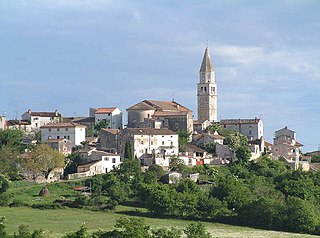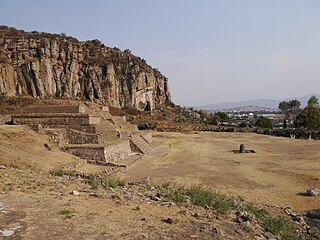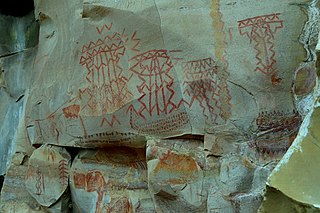
Višnjan is a village and municipality in Istria, Croatia. Višnjan is the site of Višnjan Observatory. The observatory is home of several long-running international summer programs for youth in astronomy, archeology, marine biology and other disciplines.

La Silla Observatory is an astronomical observatory in Chile with three telescopes built and operated by the European Southern Observatory (ESO). Several other telescopes are located at the site and are partly maintained by ESO. The observatory is one of the largest in the Southern Hemisphere and was the first in Chile to be used by ESO.

The Diaguita people are a group of South American indigenous people native to the Chilean Norte Chico and the Argentine Northwest. Western or Chilean Diaguitas lived mainly in the Transverse Valleys that incise semi-arid mountains. Eastern or Argentine Diaguitas lived in the provinces of La Rioja and Catamarca and part of the provinces of Salta, San Juan and Tucumán. The term Diaguita was first applied to peoples and archaeological cultures by Ricardo E. Latcham in the early 20th century.
Sarmishsay is located in the Karatau Mountain Range in the Nurata District of Navoiy Region of Uzbekistan. The gorge contains archeological remains dating back as far as the Stone Age, including two petroglyph sites with a total of 10,000 ancient rock carvings. According to UNESCO, it is the largest and most important rock art monument in Uzbekistan.

Combarbalá is the capital city of the commune of Combarbala. It is located in the Limarí Province, Region of Coquimbo, at an elevation of 900 m (2,952 ft). It is known for the tourist astronomic observatory Cruz del Sur; the petroglyphs of Rincon las Chilcas; its typical handcraft made of the unique combarbalita stone; the classical basketball match at the end February; the Virgen de la Piedra catholic-pagan festivity, among other tourist attractions.

The Pali-Aike National Park is a park located in the Magallanes Region of Patagonia in Chile. Pali-Aike is a Tehuelche name that means Desolate Place. Created in 1970, it covers an area of 5,030 hectares and includes part of the Pali-Aike Volcanic Field. The park draws its name from a prominent volcanic cone known as the Pali Aike Crater.

Salamanca is a Chilean city and commune in Choapa Province, Coquimbo Region. It is located 30 km (19 mi) east of Illapel, the province's administrative center, and 316 km (196 mi) north of Santiago, Chile. It is normally accessed from Los Vilos, which lies next to the Panamerican Highway, and connects the city to the rest of the country.

El Quisco is a Chilean city and commune in San Antonio Province, Valparaíso Region. Located in the country's central coast, it serves as a popular summer resort for the population of Santiago and forms part of the Coast of Poets, a cultural space named after four world-renowned Chilean poets: Pablo Neruda, Vicente Huidobro, Violeta Parra and Nicanor Parra. El Quisco is home to La Casa de Isla Negra, the former house of Chilean poet Pablo Neruda, which is now a museum and Neruda's burial site.

Huaca de Chena, also known as the Chena Pukara, is an Inca site on Chena Mountain, in the basin of San Bernardo, at the edge of the Calera de Tango and Maipo Province communes in Chile. Tala Canta Ilabe was the last Inca who celebrated Inti Raymi in its Ushnu.

Altavista, or Chalchihuites, is an archaeological site near the municipality of Chalchihuites in the Mexican state of Zacatecas, in the northwest of Mexico. It is believed that the site was a cultural oasis that was occupied more or less continuously from AD 100 to AD 1400.

Huapalcalco is a pre-Columbian Mesoamerican archeological site located some 5 kilometers north of Tulancingo in the state of Hidalgo, Mexico.

Xihuacan is a Mesoamerican archeological site located on the Costa Grande of the Mexican state of Guerrero, near the small town of La Soledad de Maciel, and the larger towns of Zihuatanejo and Petatlán. While pieces had been found at the site earlier, including the King of La Chole stele and Mesoamerican ball court rings, formal excavations were only recently begun. The site had been occupied for over 3,000 years and by three cultures, with contact with other Mesoamerican cultures such as the Teotihuacan and Olmec. Explored areas include what may be the largest Mesoamerican ball court, a 1-hectare (2.5-acre) pyramidal base and a hill with petroglyphs and a probable sacrifice stone.

Las Choapas is a recently found archaeological site located within the municipality of Las Choapas, in the southeastern border of the Veracruz State, inside the San Miguel de Allende Ejido, bordering the municipalities of Huimanguillo, Tabasco and Ostuacán, in Chiapas.

The Pre-Columbian period in Venezuela refers to the period before the Spanish colonization of the Americas in the 16th century, known as the Pre-Columbian era. It covers the history of what are now known as the indigenous peoples of Venezuela.

The Picture Rock Pass Petroglyphs Site is in northern Lake County, Oregon, United States. The site is located near the summit of Picture Rock Pass on land administered by the Bureau of Land Management. The designs were scraped into a basalt boulder by ancient Native Americans, probably between 7,500 and 12,000 years ago. No one knows the meaning of the petroglyph designs. Because of its unique archaeological and cultural significance, the Picture Rock Pass Petroglyph Site was listed on the National Register of Historic Places in 1975.
Nununyi was a historic village of the Cherokee people in western North Carolina, located on the eastern side of the Oconaluftee River. Today it is within the boundaries of the present-day city of Cherokee in Swain County. It was classified by English traders and colonists as among the "Out Towns" of the Cherokee in this area east of the Appalachian Mountains.

Ancon (archaeological site) is located in the north of the Bay of Ancon, in the Ancón District, on the central coast of Peru. It is one of the most important centers of the Peruvian archeology and features a vast necropolis of the pre-Hispanic era, with countless funerary sites. Permanent occupation in Ancon is documented throughout all periods of Andean history. The oldest evidence of human occupation dates back 10,000 years ago to the preceramic period.

The East Lake Abert Archeological District is an area in Lake County, Oregon, United States, that features numerous prehistoric camp sites and petroglyphs. It is located along the eastern shore of Lake Abert on land administered by the Bureau of Land Management and the Oregon Department of Transportation. The site includes stone-walled house pits and prehistoric rock art made by ancient Native Americans who occupied the site for approximately 11,000 years. Because of its unique archaeological and cultural significance, the East Lake Abert Archaeological District was listed on the National Register of Historic Places in 1978.
The origin of the Mapuche has been a matter of research for over a century. The genetics of the Mapuche do not show overly clear affinities with any other known indigenous group in the Americas, and the same goes for linguistics, where the Mapuche language is considered a language isolate. Archaeological evidence shows Mapuche culture has existed in Chile at least since 600 to 500 BC. Mapuches are late arrivals in their southernmost and easternmost (Pampas) areas of settlement, yet Mapuche history in the north towards Atacama Desert may be older than historic settlement suggest. The Mapuche has received significant influence from Pre-Incan (Tiwanaku?), Incan and Spanish peoples, but deep origins of the Mapuche predates these contacts. Contact and conflict with the Spanish Empire are thought by scholars such as Tom Dillehay and José Bengoa to have had a profound impact on the shaping of the Mapuche ethnicity.
















